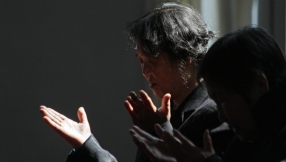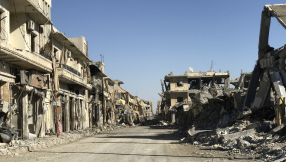Tajikistan women face hardship as young men flock to Russia
In the countryside of this Central Asian nation, women in their colourful flowing tent-like dresses are to be seen everywhere, but men of working age are scarce. In the cotton fields, which proliferate the country, most workers are women or even children, despite it being illegal for them to work.
The small town of Lensn is about 25 kilometres from the city of Qurghonteppa, formerly known as Kurgan-Tyube, the administrative capital of the Viloyati Khatlon region. In some of the rural settlements near Lensn, self-help groups have started.
These help the population solve many problems related to basics, even such as supply of water that in fully functioning societies would be dealt with after a phone call or a letter to a local authority.
The members of one of the self-help groups near Lensn sit on embroidered mats shaded from the blazing sun on an extended veranda attached to the leader's house. Only one man is there. This is normal, say the women. Some of them complain that their men folk are working in Russia and say if they were home then perhaps they could exert some pressure on the authorities to get things fixed.
"No I say, let them stay there. I haven't heard from my husband for two years, so why should he come back now," one woman exclaims and everyone laughs. But another chips in, "No, we need them here. I want my husband back."
Even if the women want their men back, there is no guarantee they will return alive. In 2005, Tajikistan's Interior Ministry said that in the first half of the year Russia had sent back the bodies of 155 Tajikistanis who went to work there as migrants. Ninety percent of them were aged 13 to 35 and most of them residents of the Khatlon region, the authorities said.
The self-help group helps negotiate micro loans for its members to help sustain their small businesses, and the woman who keeps the accounts explains the benefits to the supporting NGO, Ghamkhori.
"From the courses we've been given, I've learned to keep proper financial records," she says. "We've been taught how to write letters and to how to make a case for our businesses." These include enterprises that sell traditional crafts and others that manage their own fields of fresh produce.
Ghamkhori in turn is supported by the Ecumenical Consortium for Central Asia (ECCA), made up of British-based Christian Aid, DanChurchAid from Denmark, the Dutch Interchurch Organisation for Development Co-operation (ICCO) and Norwegian Church Aid.
This grouping has made the development of "civil society", a priority. So these Christian organizations are pumping in resources, and working along with other NGOs and international organizations. High on the agencies' agenda, and in a milieu that is now predominantly Islamic, is the humbly named "self-help group".
In 2006 an estimated 700,000 Tajikistanis, mostly men, spent some or all of the year as migrant workers in Russia and other countries, says a US Library of Congress country profile. This creates "a significant male-female imbalance in the adult population". World Bank data in 2003 found that 20 percent of households in the country were headed by a woman.
The Khatlon region, which borders on Afghanistan to the south, had some of the most heavy fighting during Tajikistan's 1992-97 civil war. It destroyed the local economy and left unemployment and underdevelopment. Many communities there have not had normal services provided by local government since the end of the Soviet Union in 1991.
A World Bank report entitled "Migrants and Remittances" from January 2007 noted: "With the break up of the Soviet Union in 1991, there was a rapid shift in the causes and patterns of migration. Russia gained 3.7 million persons through migration and became a net recipient of migration ... At the same time, 15 percent or more of the populations of Armenia, Albania, Georgia, Kazakhstan, and Tajikistan migrated permanently, many of them the better-educated and younger elements of society." The United Nations Development Programme says that migrant funds represent more than 10 per cent of the GDP in the case of Tajikistan.
During the self-help group meeting in Lensn, a girl in her early teens looked on from nearby, as she pumped water from a well to take back to her homestead in the same village. In many houses in the region people often walk long distances to collect water for homes that have no tap water.
Meanwhile, donkey carts transporting agricultural goods in the are nearly always driven by boys, mostly said to be in their teens, but in some instances looking younger than 10. Girls could be seen working the fields.
"Although Tajik legislation prohibits child labour, they harvest up to 40 percent of the cotton for paltry wages and to the detriment of their health and education," Frederic Chenais, acting head of the International Organisation for Migration, noted in a report presented in July 2004 in the Tajikistan capital Dushanbe. During the 4 to 5 months of the cotton harvest, the children earn on average less than US$20, Chenais said.
Tajikistani media in July reported that prosecutors in the south of the country were investigating accusations that school children had been taken from their classrooms and sent to the cotton fields to work for little or no payment.
The Institute of War and Peace Reporting on 13 July quoted Mirzo Fathulloev, head of the department dealing with minors at the Khatlon regional prosecutor's office as saying that police had found evidence that local authorities instructed schools to send children from the sixth to the 11th grades (aged from 11 to 17) to work in the fields at the end of May.
Cotton producers are under pressure to fulfil government-set quotas for the commodity, which is a key export earner for Tajikistan. Data from the World Bank shows that Tajikistan is the world's fourth largest exporter of cotton and the product brings much needed foreign currency into the country. It was once called "white gold". Bahodur Toshmatov, director of the Ghamkhori NGO, who has knowledge of children being taken from school to work in the fields, however, lambastes the industry as "the dictatorship of cotton".
It is a Friday as the self-help group meets in Lensn and the call to prayer sounds from the nearby Mosque. The women, and more men who have joined, joke and banter with one another as they leave to pray, knowing that they now have each other to tackle the next ordeal that afflicts them.
----------------------------------------------------------------
* This is the fourth in a series looking at the work of some of the church-backed self-help groups in this region of central Asia, and how they are affecting people's lives in an area that is both static and rapidly changing for the citizens who battle to cope there.
[Source:ENI]













